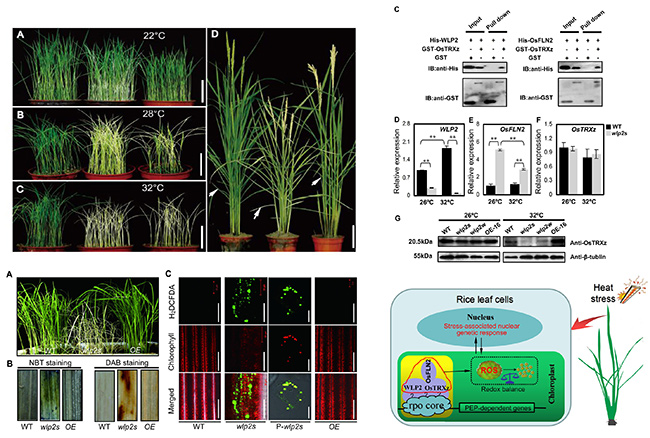






White Leaf and Panicle 2, encoding a PEP-associated protein,is required for chloroplast biogenesis under heat stress in rice
October 24th, 2017
Recently, an important progress on new regulatory mechanism of chloroplast biogenesis under higher temperature stress was achieved by a research team led by Professor Hu Peisong from China National Rice Research Institute of Chinese Academy of Agricultural Sciences.
The plastid-encoded RNA polymerase (PEP) plays an important role in the transcription machinery of mature chloroplasts, which is coated by additional proteins such as PEP-associated protein (PAPs) to build a larger chloroplast-specific PEP complex. Previous investigations in Arabidopsis suggested that PAPs display potential functions in DNA/RNA metabolism, PEP complex protection and redox regulation, PAPs also affect the activity and integrity of the PEP complex to further regulate the chloroplast transcriptional machinery. However, details of its function remain elusive in rice.
In this paper, they identified a novel PAP (WLP2) in rice by a map-based cloning strategy. Two mutants wlp2w and wlp2s were albino lethal at high temperatures. Map-based cloning suggested that WLP2 encodes a putative pfkB-type carbohydrate kinase family protein, which is homologous to fructokinase-like 1 (AtFLN1) in Arabidopsis. WLP2 is mainly expressed in green tissues and its protein localizes in chloroplasts. Expression levels of PEP-encoded genes, chloroplast development genes and photosynthesis-related genes were compromised in wlp2 mutants, indicating that WLP2 is essential for normal chloroplast biogenesis. Moreover, WLP2 and its paralog OsFLN2 can physically interact with thioredoxin OsTRXz to form a TRX-FLN regulatory module, which regulates transcription of the PEP-encoded genes and maintains the redox balance in chloroplasts under heat stress. Furthermore, the wlp2w mutant gene has a potential advantage in enhancing seed purity and high-throughput breeding. The results strongly indicate that WLP2 protects chloroplast development from heat stress via a TRX-FLN regulatory module in rice.
PhD. student Lv Yusong and Dr. Shao Gaoneng are co-first authors of this study, which is supported by the National Key Research and Development Program of China (2016YFD0101801), the National Natural Science Foundation of China (31501285, 31521064), the Science Foundation of Zhejiang province (LY14C130009) and the National S&T Major Project (2016ZX08001006). The research findings have been published online in Journal of Experimental Botany (DOI: 10.1093/jxb/erx332). More details can be accessed on the link below: https://academic.oup.com/jxb/article/doi/10.1093/jxb/erx332/4554412/White-Leaf-and-Panicle-2-encoding-a-PEP-associated

· FED:a web tool for foreign element detection of genome-edited organism
· The C2H2 zinc-finger protein LACKING RUDIMENTARY GLUME 1 regulates spikelet development in rice
· A strigolactones biosynthesis gene contributed to the Green Revolution in rice
· Natural variation in the promoter of TGW2 determines grain width and weight in rice
CNRRI Today
Copyright © 2014- China National Rice Research Institute